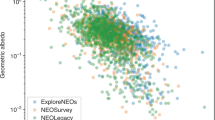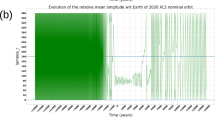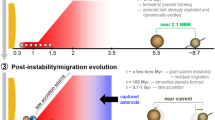Abstract
Most near-Earth objects came from the asteroid belt and drifted via non-gravitational thermal forces into resonant escape routes that, in turn, pushed them onto planet-crossing orbits1,2,3. Models predict that numerous asteroids should be found on orbits that closely approach the Sun, but few have been seen. In addition, even though the near-Earth-object population in general is an even mix of low-albedo (less than ten per cent of incident radiation is reflected) and high-albedo (more than ten per cent of incident radiation is reflected) asteroids, the characterized asteroids near the Sun typically have high albedos4. Here we report a quantitative comparison of actual asteroid detections and a near-Earth-object model (which accounts for observational selection effects). We conclude that the deficit of low-albedo objects near the Sun arises from the super-catastrophic breakup (that is, almost complete disintegration) of a substantial fraction of asteroids when they achieve perihelion distances of a few tens of solar radii. The distance at which destruction occurs is greater for smaller asteroids, and their temperatures during perihelion passages are too low for evaporation to explain their disappearance. Although both bright and dark (high- and low-albedo) asteroids eventually break up, we find that low-albedo asteroids are more likely to be destroyed farther from the Sun, which explains the apparent excess of high-albedo near-Earth objects and suggests that low-albedo asteroids break up more easily as a result of thermal effects.
This is a preview of subscription content, access via your institution
Access options
Subscribe to this journal
Receive 51 print issues and online access
$199.00 per year
only $3.90 per issue
Buy this article
- Purchase on Springer Link
- Instant access to full article PDF
Prices may be subject to local taxes which are calculated during checkout



Similar content being viewed by others
References
Morbidelli, A. & Vokrouhlický, D. The Yarkovsky-driven origin of near Earth asteroids. Icarus 163, 120–134 (2003)
Morbidelli, A., Bottke, W. F. Jr, Froeschlé, C. & Michel, P. Origin and evolution of near-Earth objects. Asteroids III, 409–422 (2002)
Bottke, W. F., Jedicke, R., Morbidelli, A., Petit, J.-M. & Gladman, B. Understanding the distribution of near-Earth asteroids. Science 288, 2190–2194 (2000)
Mainzer, A. et al. Characterizing subpopulations within the near-Earth objects with NEOWISE: preliminary results. Astrophys. J. 752, 110 (2012)
Jedicke, R., Bolin, B., Granvik, M. & Beshore, E. A fast method for quantifying observational selection effects in asteroid surveys. Icarus 266, 173–188 (2016)
Bottke, W. F. et al. Debiased orbital and absolute magnitude distribution of the near-Earth objects. Icarus 156, 399–433 (2002)
Greenstreet, S., Ngo, H. & Gladman, B. The orbital distribution of near-Earth objects inside Earth’s orbit. Icarus 217, 355–366 (2012)
Harris, A. W. & D’Abramo, G. The population of near-Earth asteroids. Icarus 257, 302–312 (2015)
Campins, H., Davis, D. R., Weidenschilling, S. J. & Magee, M. in Completing the Inventory of the Solar System (eds Rettig, T. & Hahn, J. M. ) Astron. Soc. Pacif. Conf. Ser. 107, 85–96 (1996)
Lewis, J. S. Physics and Chemistry of the Solar System 257–259 (Elsevier Academic Press, 2004)
Delbo, M. et al. Thermal fatigue as the origin of regolith on small asteroids. Nature 508, 233–236 (2014)
Jewitt, D. The active asteroids. Astron. J. 143, 66 (2012)
Vokrouhlický, D., Bottke, W. F., Chesley, S. R., Scheeres, D. J. & Statler, T. S. The Yarkovsky and YORP effects. Asteroids IV, 509–531 (2015)
Steckloff, J. K. & Jacobson, S. A. The formation of striae within cometary dust tails by a sublimation-driven YORP-like effect. Icarus 264, 160–171 (2016)
Feigelson, E. D. & Jogesh Babu, G. Modern Statistical Methods for Astronomy 105–117 (Cambridge Univ. Press, 2012)
Jewitt, D., Li, J. & Agarwal, J. The dust tail of asteroid (3200) Phaethon. Astrophys. J. 771, L36 (2013)
Brown, P., Weryk, R. J., Wong, D. K. & Jones, J. A meteoroid stream survey using the Canadian Meteor Orbit Radar. I. Methodology and radiant catalogue. Icarus 195, 317–339 (2008)
Brown, P., Wong, D. K., Weryk, R. J. & Wiegert, P. A meteoroid stream survey using the Canadian Meteor Orbit Radar. II: identification of minor showers using a 3D wavelet transform. Icarus 207, 66–81 (2010)
Rivkin, A. S., Howell, E. S., Vilas, F. & Lebofsky, L. A. Hydrated minerals on asteroids: the astronomical record. Asteroids III, 235–253 (2002)
Hsieh, H. H. & Jewitt, D. A population of comets in the main asteroid belt. Science 312, 561–563 (2006)
Küppers, M. et al. Localized sources of water vapour on the dwarf planet (1) Ceres. Nature 505, 525–527 (2014)
Mainzer, A. et al. NEOWISE observations of near-Earth objects: preliminary results. Astrophys. J. 743, 156 (2011)
Acknowledgements
Discussions with D. Nesvorný, K. Tsiganis and S. Jacobson as well as a review by A. Harris helped improve the manuscript. M.G. was funded by grant 137853 from the Academy of Finland and D.V. by grant GA13-01308S of the Czech Science Foundation. W.F.B. thanks NASA’s Near Earth Object Observation programme for supporting his work in this project. We acknowledge support by ESA via contract AO/1-7015/11/NL/LvH (Synthetic Generation of a NEO Population). CSC – IT Centre for Science Ltd, Finland, the Finnish Grid Infrastructure and the mesocentre SIGAMM at the Observatoire de la Côte d’Azur provided computational resources.
Author information
Authors and Affiliations
Contributions
M.G. conceived the disruption model. M.G., A.M. and W.F.B. carried out orbital integrations using code modified by D.V. and A.M. R.J., B.B., M.G. and E.B. estimated observational biases for CSS. M.G. developed the code for fitting model parameters and carried out the fits. M.D. provided expertise on the WISE albedo analysis. M.G. wrote the paper with input from all authors.
Corresponding author
Ethics declarations
Competing interests
The authors declare no competing financial interests.
Additional information
The code for orbital integrations, SWIFT, is available at https://www.boulder.swri.edu/~hal/downloads.
Supplementary information
Supplementary Information
This file contains a detailed description of the modelling approach describing the generation of steady-state orbit distributions, estimation of observational selection effects, and estimation of model parameters, Supplementary Figures 1–14 and Supplementary References. (PDF 2783 kb)
Debiased NEO orbital distribution
The fractional NEO orbit (a,e,i) distribution as a function of H when assuming a disruption at q⋆= 0.076 au. (MP4 79 kb)
Rights and permissions
About this article
Cite this article
Granvik, M., Morbidelli, A., Jedicke, R. et al. Super-catastrophic disruption of asteroids at small perihelion distances. Nature 530, 303–306 (2016). https://doi.org/10.1038/nature16934
Received:
Accepted:
Published:
Issue Date:
DOI: https://doi.org/10.1038/nature16934
This article is cited by
-
Thermal decomposition as the activity driver of near-Earth asteroid (3200) Phaethon
Nature Astronomy (2023)
-
Alignment of fractures on Bennu’s boulders indicative of rapid asteroid surface evolution
Nature Geoscience (2022)
-
Multidimensional Analysis of Near-Earth Asteroids
SN Computer Science (2022)
-
Shapes, structures, and evolution of small bodies
Astrodynamics (2021)
-
In situ evidence of thermally induced rock breakdown widespread on Bennu’s surface
Nature Communications (2020)
Comments
By submitting a comment you agree to abide by our Terms and Community Guidelines. If you find something abusive or that does not comply with our terms or guidelines please flag it as inappropriate.



